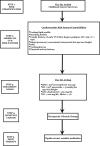Detection of metabolic syndrome features among childhood cancer survivors: a target to prevent disease
- PMID: 19065999
- PMCID: PMC2597761
- DOI: 10.2147/vhrm.s2881
Detection of metabolic syndrome features among childhood cancer survivors: a target to prevent disease
Abstract
Along with the growing epidemic of obesity, the risk of atherosclerosis, cardiovascular disease morbidity, and mortality are increasing markedly. Several risk factors for cardiovascular disease, such as visceral obesity, glucose intolerance, arterial hypertension, and dyslipidemia commonly cluster together as a condition currently known as metabolic syndrome. Thus far, insulin resistance, and endothelial dysfunction are the primary events of the metabolic syndrome. Several groups have recommended clinical criteria for the diagnosis of metabolic syndrome in adults. Nonetheless, in what concerns children and adolescents, there are no unified definitions, and modified adult criteria have been suggested by many authors, despite major problems. Some pediatric disease states are at risk for premature cardiovascular disease, with clinical coronary events occurring very early in adult life. Survivors of specific pediatric cancer groups, particularly acute lymphocytic leukemia, central nervous system tumors, sarcomas, lymphomas, testicular cancer, and following bone marrow transplantation, may develop metabolic syndrome traits due to: hormonal deficiencies (growth hormone deficiency, thyroid dysfunction, and gonadal failure), drug or radiotherapy damage, endothelial impairment, physical inactivity, adipose tissue dysfunction, and/or drug-induced magnesium deficiency. In conclusion, some primary and secondary prevention remarks are proposed in order to reduce premature cardiovascular disease risk in this particular group of patients.
Figures
References
-
- Adan L, Trivin C, Sainte-Rose C, et al. GH deficiency caused by cranial irradiation during childhood: factors and markers in young adults. J Clin Endocrinol Metab. 2001;86:5245–51. - PubMed
-
- Ahmet A, Blaser S, Stephens D, et al. Weight gain in craniopharyngioma –a model for hypothalamic obesity. J Pediatr Endocrinol Metab. 2006;19:121–8. - PubMed
-
- Alberti KGMM, Zimmet PZ. World Health Organisation (WHO) – Definition, diagnosis and classification of diabetes mellitus and its complications. Part 1: diagnosis and classification of diabetes mellitus provisional report of a WHO consultation. Diabet Med. 1998;15:539–53. - PubMed
-
- [AAP] American Academy of Pediatrics. National Cholesterol Education Program: report of the Expert Panel on Blood Cholesterol Levels in Children and Adolescents. Pediatrics. 1992;89(pt 2):525–84. - PubMed
-
- [ADA] American Diabetes Association Type 2 diabetes in children and adolescents. Diabetes Care. 2000;23:381–9. - PubMed
Publication types
MeSH terms
Substances
LinkOut - more resources
Full Text Sources
Medical


